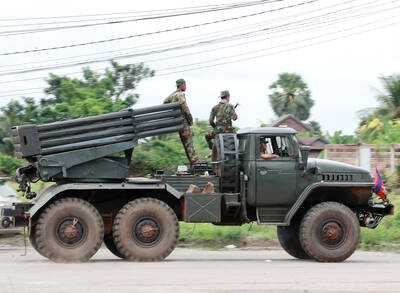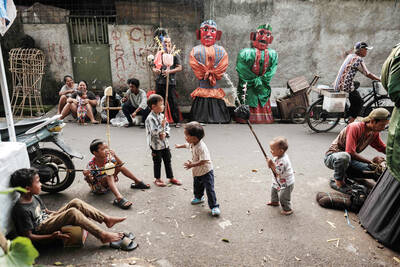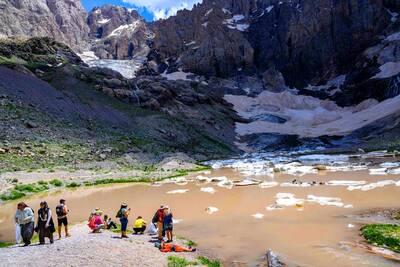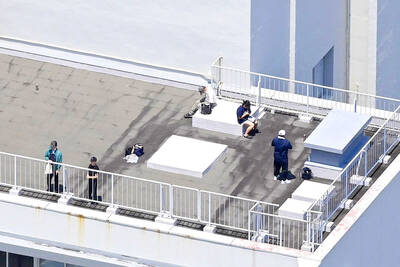South Korea dismissed reports yesterday that recently-released photographs of North Korean leader Kim Jong-il may have been doctored, amid continued speculation over the North Korean leader’s health.
Pyongyang on Wednesday released a still photo of Kim at the front of a military lineup in its latest effort to quell rumors that the 66-year-old had suffered a stroke in mid-August.
The Times newspaper and the BBC questioned the authenticity of the image, citing differently-angled shadows and mismatching pixels.
But Seoul’s main spy agency, the National Intelligence Service (NIS), said yesterday that it believed the latest North Korean photo was real.
“The possibility of Mr. Kim’s photo being forged seems very low,” an NIS spokesman said, refusing to elaborate.
He declined to comment on questions raised by the British media about the photograph.
Unification Ministry spokesman Kim Ho-nyoun also said he had no evidence to suggest that the photo had been forged.
“From the observation with our naked eyes, we have found nothing unusual,” the spokesman said.
North Korea has not said when the recently-released photographs of Kim were taken.
Kim’s health is the subject of intense speculation because he has not publicly nominated a successor — as his father had done more than 20 years before his death in 1994 — to run the impoverished, nuclear-armed state.
After he failed to attend a Sept. 9 parade marking the country’s 60th anniversary, South Korean and US officials said Kim suffered a stroke around mid-August but was recovering well.
Japanese Prime Minister Taro Aso said last week Kim was probably in hospital but still capable of making decisions.
But some reports said Kim may have suffered partial paralysis from his stroke.
Giving new life to speculation about Kim’s health, the Times on Friday suggested the Wednesday-released photo might have been doctored.
In the photo, the shadow of Kim runs differently from those of soldiers on either side of him, the Times said, adding that a dark line running along the stand mysteriously vanishes on either side of Kim — suggesting his picture may have been superimposed onto the image.

POLITICAL PATRIARCHS: Recent clashes between Thailand and Cambodia are driven by an escalating feud between rival political families, analysts say The dispute over Thailand and Cambodia’s contested border, which dates back more than a century to disagreements over colonial-era maps, has broken into conflict before. However, the most recent clashes, which erupted on Thursday, have been fueled by another factor: a bitter feud between two powerful political patriarchs. Cambodian Senate President and former prime minister Hun Sen, 72, and former Thai prime minister Thaksin Shinawatra, 76, were once such close friends that they reportedly called one another brothers. Hun Sen has, over the years, supported Thaksin’s family during their long-running power struggle with Thailand’s military. Thaksin and his sister Yingluck stayed

In the sweltering streets of Jakarta, buskers carry towering, hollow puppets and pass around a bucket for donations. Now, they fear becoming outlaws. City authorities said they would crack down on use of the sacred ondel-ondel puppets, which can stand as tall as a truck, and they are drafting legislation to remove what they view as a street nuisance. Performances featuring the puppets — originally used by Jakarta’s Betawi people to ward off evil spirits — would be allowed only at set events. The ban could leave many ondel-ondel buskers in Jakarta jobless. “I am confused and anxious. I fear getting raided or even

Kemal Ozdemir looked up at the bare peaks of Mount Cilo in Turkey’s Kurdish majority southeast. “There were glaciers 10 years ago,” he recalled under a cloudless sky. A mountain guide for 15 years, Ozdemir then turned toward the torrent carrying dozens of blocks of ice below a slope covered with grass and rocks — a sign of glacier loss being exacerbated by global warming. “You can see that there are quite a few pieces of glacier in the water right now ... the reason why the waterfalls flow lushly actually shows us how fast the ice is melting,” he said.

Residents across Japan’s Pacific coast yesterday rushed to higher ground as tsunami warnings following a massive earthquake off Russia’s far east resurfaced painful memories and lessons from the devastating 2011 earthquake and nuclear disaster. Television banners flashed “TSUNAMI! EVACUATE!” and similar warnings as most broadcasters cut regular programming to issue warnings and evacuation orders, as tsunami waves approached Japan’s shores. “Do not be glued to the screen. Evacuate now,” a news presenter at public broadcaster NHK shouted. The warnings resurfaced memories of the March 11, 2011, earthquake, when more than 15,000 people died after a magnitude 9 tremor triggered a massive tsunami that